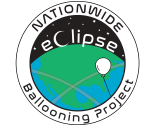
Eclipse Ballooning Project
Send live video and images from near space.
More Information
Building on the highly successful NASA and NSF-sponsored National Eclipse Ballooning Project (NEBP) implemented during the 2017, 2019, and 2020 total solar eclipses, this new effort will broaden participation of STEM learners by immersing teams from a wide range of higher education institutions in an innovative NASA-mission-like adventure in data acquisition and analysis through scientific ballooning during the 10/14/2023 annular and 4/8/2024 total solar eclipses.
Since the early 2000s, scientific ballooning has been a common hands-on STEM learning activity in the US. Academic ballooning uses weather balloons carrying payloads of experiments weighing a total of less than 12 pounds to altitudes of approximately 100,000 feet. At these altitudes – above 99.5% of the atmosphere – payloads experience a space-like environment. Academic ballooning types can be generalized into two categories: 1) atmospheric science radiosondes and 2) student-built engineering platforms. Radiosondes are small standardized commercial off-the-shelf payloads of less than 190 grams that are used to measure atmospheric parameters through the stratosphere. Typical atmospheric science experiments include understanding gravity waves, planetary boundary layer changes, and weather patterns. Engineering balloon platforms are capable of lifting up to 12 pounds of student built payloads into the stratosphere. Typical engineering platform experiments include atmospheric measurements, imaging, cosmic radiation measurements, and space technology proofs of concept.
NEBP includes development and implementation of two learner-centered activity tracks – engineering and atmospheric science. At sites along the eclipse path, student teams in the engineering track will use innovative larger balloon systems to live stream video to the NASA eclipse website, observe in situ perturbations in atmospheric phenomena, and conduct individually designed experiments. Atmospheric science track teams will make frequent observations by launching hourly radiosondes on helium-filled weather balloons. Student participants will work with atmospheric science experts throughout the project and will publish results in peer-reviewed journals.
The project will fully support 55 teams. The 55 teams are divided into nine pods to facilitate effective education. NEBP will provide a learning environment that uses evidence and equity-based practices to make certain the 1,000+ participants are (and feel) supported, engaged, and valued. In addition, NEBP will provide infrastructure tools and best practices to help participating institutions build collaborations that could continue far beyond the scope of this project.
NEBP is supported by NASA’s Science Mission Directorate Science Activation program and by NASA’s Space Grant College and Fellowship program. (Award number 80NSSC22M0003)
Ticket Required: No
Minimum Age: 13
Languages: English
